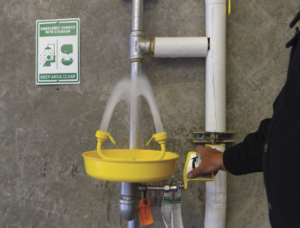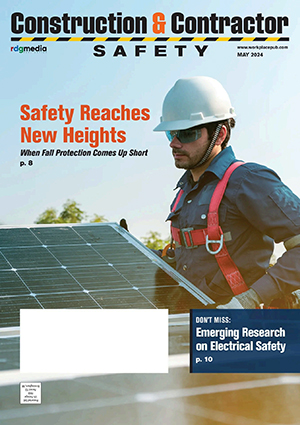Eyewash Training Can Make the Difference
Save precious moments by emphasizing the buddy system during safety training.
By: Maureen Paraventi

Training should include a demonstration of how to use the lever on an eyewash to turn the water stream on.
The workplace you manage or supervise has hazardous chemicals on site, but you’ve made sure — based on a thorough risk assessment — that it also has a sufficient number of eyewashes and emergency showers in place. Additionally, you have them checked and activated regularly, to ensure that they remain operational and hygienic. You let all employees who must perform tasks with or in the vicinity of hazardous chemicals know that eyewashes and emergency showers are available, should the worst occur.
Then the worst occurs.
Corrosive chemicals splash a worker in the eyes. Wracked with pain, he knows he has to flush his eyes quickly — but the chemical burns prevent him from opening his eyes fully, so he stumbles blindly toward where he thinks the eyewash station is. He knows it’s not far from where the incident occurred, but someone has placed stacks of bins in an unusual place. Navigating around the unexpected obstacle slows him down further. When he reaches the emergency equipment, stressed, frightened by the thought that he might suffer vision loss and still unable to see well, he fumbles to activate the flow of water that will bring him relief.
This type of scenario can occur even in workplaces that prioritize safety. Although emergency eyewashes are designed to be user friendly, the circumstances of a chemical eye injury can interfere with or delay access to this vital form of first aid. Physical and emotional factors can seriously delay first aid. Training can make the difference between a life-changing, disabling injury and one whose health effects are short-term. Emphasizing the buddy system in that training will increase the likelihood that an injured worker will get to the eyewash station quickly and use it correctly.
EYEWASH TRAINING TIPS
Start with a reminder of where eyewash stations are located. Even if they are brightly colored and in prominent places, workers may stop taking note of them due to a phenomenon called attentional saturation.1 This happens when we see the same thing over and over again — such as items in the background of a warehouse or factory as we walk through it. Our brains stop noting individual details, like eyewashes.
- If you’ve followed best practices2, eyewash stations will be:
- Close to hazards and on the same floor as hazards
- Marked by highly visible signs with symbols on them — not words that require language skills
- Near an emergency exit, for quick access by emergency response personnel
- On a path that is free of obstructions
- Not be separated by a partition from the hazardous work area
- Stress the importance of acting quickly. Starting the flushing process within 10 to 15 seconds of the exposure incident will increase the chances of a full recovery.
- Make sure the injured person does not rub the affected eye. That could make the damage worse.
- Call 9-1-1 if the injury is severe.
- Emphasize the need for a co-worker to escort the injured person to the eyewash and assist them with the procedure.
- Act upon all contaminants, even those that are not considered as hazardous as corrosive chemicals. Sawdust and other particles can cause irritation and inflammation if they aren’t flushed out right away.
- Remove contact lenses immediately, so that contaminants don’t become trapped under them.
- Demonstrate how to:
- Use the lever on the eyewash to turn the water stream on. Explain how the temperature of the water can be adjusted for comfort.
- Bend over and tilt the head down, then hold the eye open with a thumb and finger to allow the water to irrigate it. The “buddy” of the injured worker should remind them to move their head up and down and side to side. This helps remove contaminants from the eyelids.
- Stress the need to flush the eye or eyes for a sufficient length of time. Safety data sheets (SDS) specify flushing times for hazardous substances. Ideally, everyone who may be potentially exposed to substances should be familiar with the SDS guidance. However, in an emergency, when every second counts, it may not be possible to consult the SDS quickly. If that’s the case, or if the exact product is unknown, flush for a minimum of 20 minutes. If the chemical properties are known, the following guide2 can be used:
- 5-minutes for non-irritants or mild irritants,
- 15-20 minutes for moderate to severe irritants and chemicals that cause acute toxicity if absorbed through the skin,
- 30 minutes for most corrosives, and
- 60 minutes for strong alkalis (e.g., sodium, potassium or calcium hydroxide).
- If irritation continues, repeat the flushing procedure.
- An emergency shower should never be used to flush eyes. The water pressure in showers is too strong, and could exacerbate an eye injury.
Whether your workplace is a warehouse or a factory, a commercial kitchen, construction site, laboratory or hospital, simply having eye stations if there is a risk of eye injury is not enough. In order to ensure that an eyewash station is properly used in the event of an emergency, training and refresher training must be conducted as well. WMHS



